中考英语二轮专项复习课件 第01讲句子结构和句子成分
文档属性
| 名称 | 中考英语二轮专项复习课件 第01讲句子结构和句子成分 | 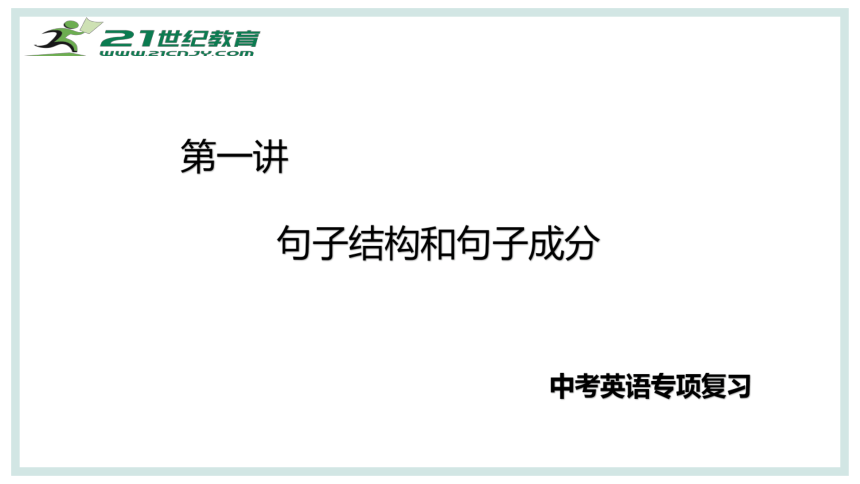 | |
| 格式 | pptx | ||
| 文件大小 | 1.8MB | ||
| 资源类型 | 试卷 | ||
| 版本资源 | 鲁教版 | ||
| 科目 | 英语 | ||
| 更新时间 | 2023-11-12 22:56:48 | ||
图片预览

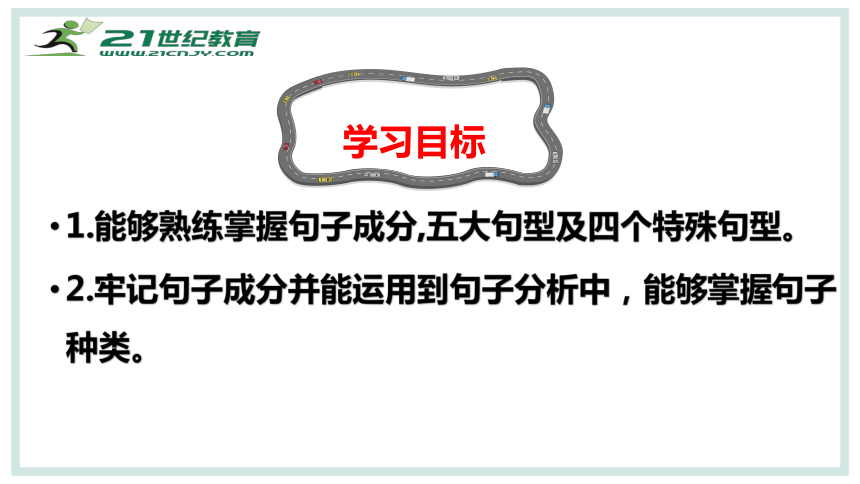
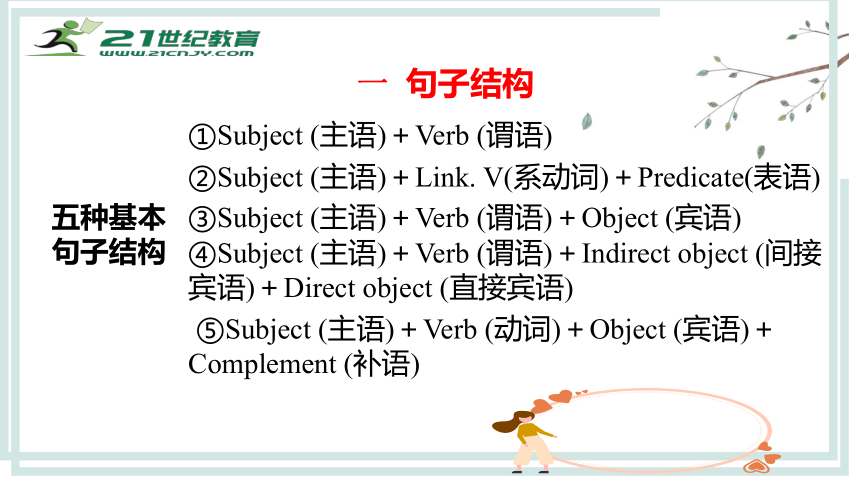

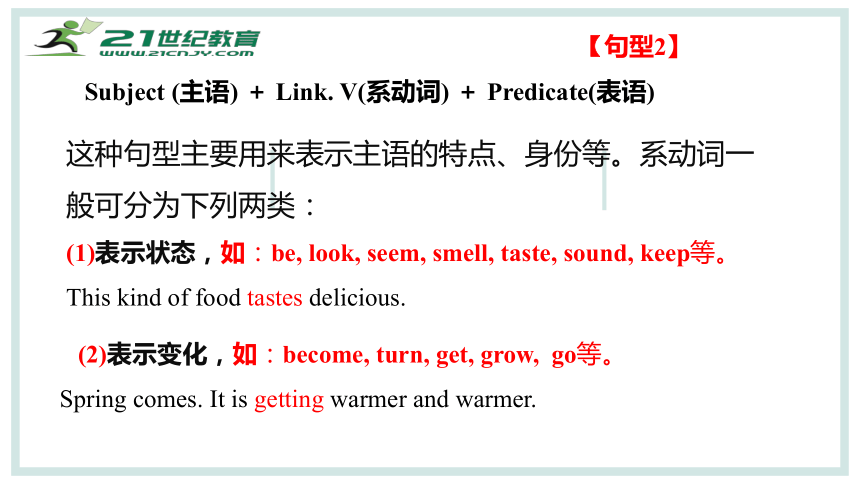
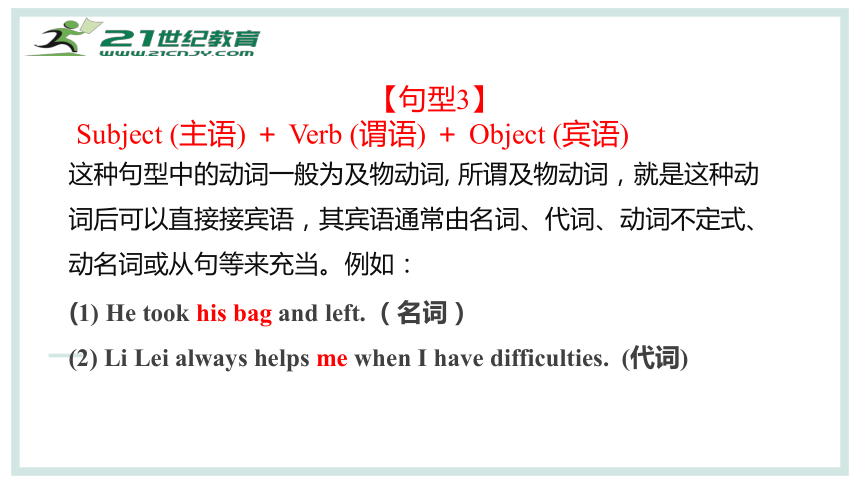
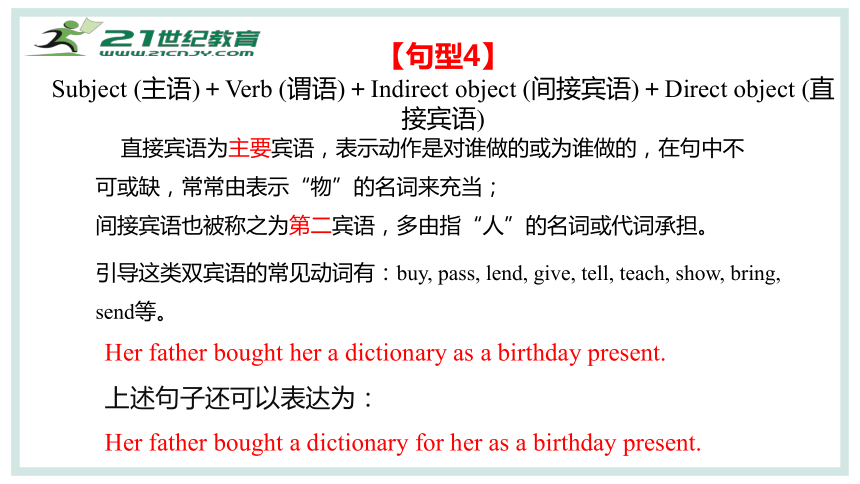
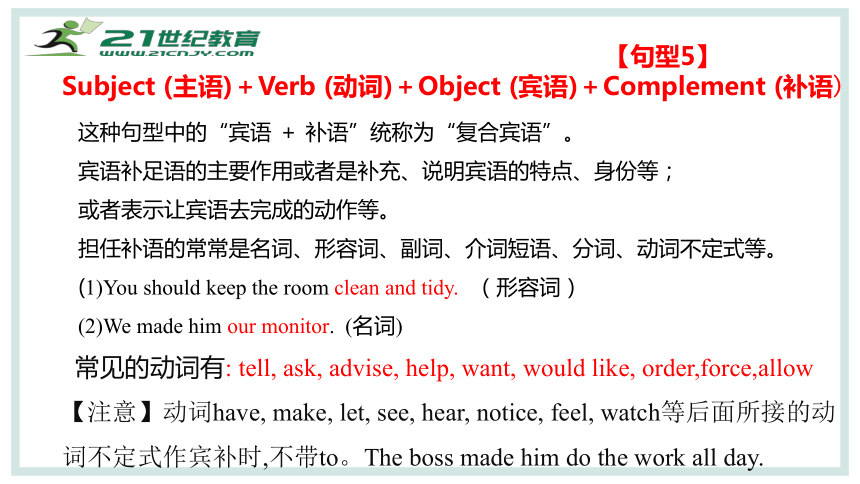

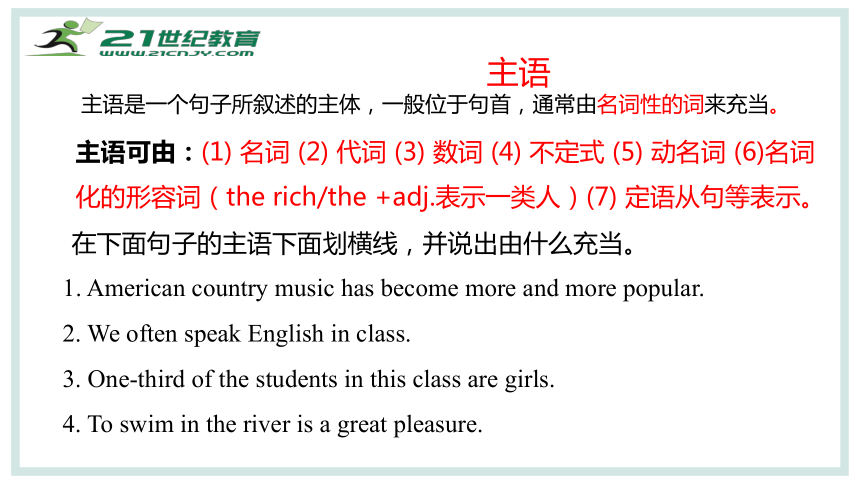
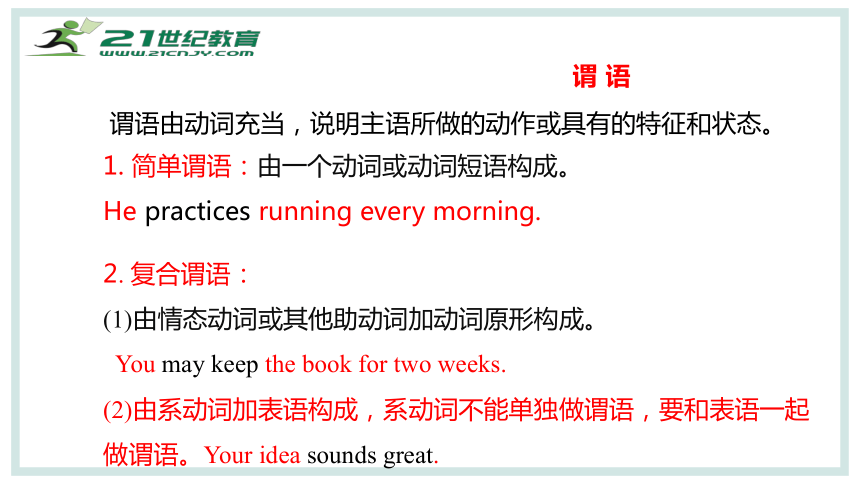

文档简介
(共34张PPT)
第一讲
句子结构和句子成分
中考英语专项复习
1.能够熟练掌握句子成分,五大句型及四个特殊句型。
2.牢记句子成分并能运用到句子分析中,能够掌握句子种类。
学习目标
一 句子结构
五种基本
句子结构
①Subject (主语)+Verb (谓语)
②Subject (主语)+Link. V(系动词)+Predicate(表语)
③Subject (主语)+Verb (谓语)+Object (宾语)
④Subject (主语)+Verb (谓语)+Indirect object (间接宾语)+Direct object (直接宾语)
⑤Subject (主语)+Verb (动词)+Object (宾语)+ Complement (补语)
夏はスイカを食べるしかない
此句型中的动词大多是不及物动词,所谓不及物动词,就是这种动词后不可以直接接宾语。
【句型1】
Subject (主语) + Verb (谓语)
常见的动词有:work, sing, swim, fish, jump, arrive, come, die, disappear, cry, happen等。
例如:
Li Ming works very hard.
The accident happened yesterday afternoon.
这种句型主要用来表示主语的特点、身份等。系动词一般可分为下列两类:
【句型2】
Subject (主语) + Link. V(系动词) + Predicate(表语)
(2)表示变化,如:become, turn, get, grow, go等。
Spring comes. It is getting warmer and warmer.
(1)表示状态,如:be, look, seem, smell, taste, sound, keep等。
This kind of food tastes delicious.
文本信息
标题数字等都可以通过点击和重新输入进行更改。文字数字大小颜色参考此模板
【句型3】
Subject (主语) + Verb (谓语) + Object (宾语)
这种句型中的动词一般为及物动词, 所谓及物动词,就是这种动词后可以直接接宾语,其宾语通常由名词、代词、动词不定式、动名词或从句等来充当。例如:
(1) He took his bag and left. (名词)
(2) Li Lei always helps me when I have difficulties. (代词)
【句型4】
Subject (主语)+Verb (谓语)+Indirect object (间接宾语)+Direct object (直接宾语)
直接宾语为主要宾语,表示动作是对谁做的或为谁做的,在句中不可或缺,常常由表示“物”的名词来充当;
间接宾语也被称之为第二宾语,多由指“人”的名词或代词承担。
引导这类双宾语的常见动词有:buy, pass, lend, give, tell, teach, show, bring, send等。
Her father bought her a dictionary as a birthday present.
上述句子还可以表达为:
Her father bought a dictionary for her as a birthday present.
【句型5】
Subject (主语)+Verb (动词)+Object (宾语)+Complement (补语)
这种句型中的“宾语 + 补语”统称为“复合宾语”。
宾语补足语的主要作用或者是补充、说明宾语的特点、身份等;
或者表示让宾语去完成的动作等。
担任补语的常常是名词、形容词、副词、介词短语、分词、动词不定式等。
(1)You should keep the room clean and tidy. (形容词)
(2)We made him our monitor. (名词)
常见的动词有: tell, ask, advise, help, want, would like, order,force,allow
【注意】动词have, make, let, see, hear, notice, feel, watch等后面所接的动词不定式作宾补时,不带to。The boss made him do the work all day.
二 【句子成分】
概念:构成句子的各个部分叫做句子成分。
句子成分有主要成分和次要成分。
主要成分: 主语和谓语。
次要成分: 表语、宾语、定语、状语、补足语和同位语。
在下面句子的主语下面划横线,并说出由什么充当。
1. American country music has become more and more popular.
2. We often speak English in class.
3. One-third of the students in this class are girls.
4. To swim in the river is a great pleasure.
主语
主语是一个句子所叙述的主体,一般位于句首,通常由名词性的词来充当。
主语可由:(1) 名词 (2) 代词 (3) 数词 (4) 不定式 (5) 动名词 (6)名词化的形容词(the rich/the +adj.表示一类人)(7) 定语从句等表示。
谓 语
谓语由动词充当,说明主语所做的动作或具有的特征和状态。
1. 简单谓语:由一个动词或动词短语构成。
He practices running every morning.
2. 复合谓语:
(1)由情态动词或其他助动词加动词原形构成。
You may keep the book for two weeks.
(2)由系动词加表语构成,系动词不能单独做谓语,要和表语一起做谓语。Your idea sounds great.
输入文本信息
标题数字等都可以通过点击和重新输入进行更改。文字数字大小颜色参考此模板
输入文本信息
标题数字等都可以通过点击和重新输入进行更改。文字数字大小颜色参考此模板
表 语
表语用以说明主语的身份、特征和状态,它一般位于系动词(如be,become, get, look, grow, turn, seem等)之后。
表语一般由名词、代词、形容词、分词、数词、不定式、动名词、介词短语、副词及表语从句表示。
Our English teacher is an American.(名词)
Is it yours (代词)
The weather has turned cold.(形容词)
The speech is exciting.(分词)
宾 语
宾语表示动作的对象或承受者,一般位于及物动词和介词后面。
宾语由名词性的词充当,分为动词宾语和介词宾语,分别构成:动宾结构和介宾结构。
They helped the old with their housework yesterday.(名词化形容词)
He pretended not to see me.(不定式短语)
I enjoy listening to popular music.(动名词短语)
I think(that)he is fit for his office.(宾语从句)
宾语种类:
(1)双宾语(间接宾语+直接宾语) Lend me your dictionary, please.
一人一物做宾语构成双宾语
(2)复合宾语(宾语+宾补) They elected him their monitor.
输入标题文本信息
标题数字等都可以通过点击和重新输入进行更改。文字数字大小颜色参考此模板
宾语补足语
英语中有些及物动词,除有一个直接宾语以外,还要有一个宾语补语,才能使句子的意义完整
带有宾语补足语的一般句型为:某些及物动词(如make等+宾语+宾补)。
宾补可由名词、形容词、副词、不定式、分词、介词短语和从句充当。
You mustn’t force him to lend his money to you.(不定式短语)
We saw her entering the room.(现在分词)
We found everything in the lab in good order.(介词短语)
We will soon make our city what your city is now.(从句)
输入文本信息
点击此处输入文本信息。标题数字等都可以通过点击和重新输入进行更改,菜单设置中功能区可以对字体、字号、颜色、行距等进行修改。文字数字大小颜色参考此模板
定 语
定语是对名词或代词起修饰、限定作用的词、短语或句子,汉语中常用“......的”表示。
定语通常位于被修饰的名词前。
但许多情况下,定语是放在所修饰词后面的:
①副词用作定语一般要后置。People there are very friendly.
②形容词短语作定语一般放在所修饰词之后,单个形容词作定语放在修饰词的前面。The man next to me is a teacher.
③介词短语作定语时要后置。The boy under the tree is Tom.
④现在分词短语、过去分词短语、动词不定式做定语常后置。
The girl crying over there is my sister. The house built last year is beautiful.
状 语
修饰动词、形容词、副词或整个句子,说明动作或状态特征的句子成分,叫做状语。
1. Light travels most quickly.(副词quickly修饰动词travel作状语)
2.This material is environmentally friendly. (修饰形容词用副词,作状语)
3.He runs very slowly. (修饰副词slowly,因此very是副词,作状语)
4.Unfortunately, he lost all of his money.(修饰整个句子用副词,做状语)
5.Once you begin, you must continue.(状语从句)
状语种类如下:
How about meeting again at six (时间状语)(表示时间是时间状语,表示原因是原因状语)
Last night she didn’t go to the dance party because of the rain.(原因状语)
I shall go there if it doesn’t rain.(条件状语)
In order to catch up with the others, I must work harder.(目的状语)
He was so tired that he fell asleep immediately.(结果状语)
【句子种类】
英语句子按照使用目的和交际功能,可分为四大类:
陈述句、疑问句、祈使句和感叹句。
陈述句
说明一个事实或陈述一个看法,有肯定式和否定式,语序是主语在前,谓语在后。
I live in Tianjin. (肯定句) We don’t live in Shanghai. (否定句)
疑问句
疑问句用来提出问题,句末用问号“?”。
一般疑问句
特殊疑问句
选择疑问句
反意疑问句
一般疑问句
点击此处
输入文本信息
①用来询问一件事,答案通常是yes或no,注意语序。
—Do you often speak English at school —Yes, I do. /No, I don’t.
②否定式的一般疑问句。此类一般疑问句表示反问或惊讶,通常用be动词、
情态动词或助动词后加not的缩写形式构成,放在句首。
③用yes, no之外的词回答的一般疑问句。
一般疑问句也可用其他表示肯定或否定的词回答,如:certainly, sure, of course, I think so, all right, with pleasure, perhaps 等代替yes, certainly not, not at all, never, I’m sorry, not yet, I’m afraid not等代替no. 如:
—Would you mind my joining your talk/discussion —Of course not.
特殊疑问句
常用的疑问词有:
what/who/whom/whose/which/when/where/how/why/howmany/how much等。
以特殊疑问词开头,对句中某一成分提问的句子叫特殊疑问句。
选择疑问句
点击此处
输入文本信息
一种以一般疑问句为基础,
另一种以特殊疑问句为基础,or连接的两个并列成分可以是状语、宾语、表语、谓语或是两个句子等。
一般选择疑问句(以一般疑问句为基础)
Is her brother an artist or a doctor
特殊选择疑问句(以特殊疑问句为基础)
Who is taller, Mike or Jimmy
选择疑问句是说话者对问题提出两个或两个以上的答案,供对方选择其一。这种疑问句有两种形式:
反意疑问句
点击此处
输入文本信息
必须遵循的原则是“三同一反”:两部分的人称、时态、动词相同,前肯后否,前否后肯。
否定的疑问句中的助动词必须缩写,主语(最后一个词)必须是代词而不能是名词。
反意疑问句表示提问者有一定的主见,但没把握,希望对方来证实。
反意疑问句结构:肯定的陈述句+否定的疑问句(缩略形式)
否定的陈述句+肯定的疑问句(缩略形式)
反意疑问句
点击此处
输入文本信息
结构一:前肯+后否 eg. He is clever, isn’t he
结构二:前否+后肯 eg. He isn’t clever, is he
Your sister has ever been to Shanghai , hasn’t she
The boys didn’t find anything, did they
在回答反意疑问句时,要根据事实而定,事实是肯定的要回答Yes , ...;事实是否定的要回答No, ... 注意在前否后肯的反意疑问句中,yes“不” No “是”。
He isn’t going to the meeting , is he Yes, he is. / No, he isn’t.
反意疑问句
点击此处
输入文本信息
a.no/not之外的否定意义的反意疑问句。若陈述句中含有表否定意义的词,如never, hardly, few, little, seldom等,构成反意疑问句,附加疑问部分用肯定式。
Maria has few friends, ____________
b.句中含否定前缀的反意疑问句。陈述部分含有带否定前缀的词,如dislike, unhappy, untrue, impossible, disagree 等,依然要把陈述句看做肯定句,反意疑问部分用否定式。He dislikes volleyball, _____________
c.主语为不定代词的反意疑问句。若陈述句主语是表物的everything, something, anything, nothing,疑问部分的主语用it。
Nothing has been considered about this meeting, hasn’t it
祈使句
点击此处
输入文本信息
表达命令、要求、请求、劝告等,动词用原形。
Go back to your seat , please.
Let’s go to school together!
Let’s开头的祈使句否定形式是Let’s (us , me)+not +动词原形。
Let’s not say anything about it.
有时为了委婉,在句首或句尾加上please,若加在末尾,前面要用逗号隔开。
Please sit down. Stand up, please.
感叹句
表示喜怒哀乐等强烈感情时用感叹句。
点击此处
输入文本信息
how作状语,修饰形容词,副词或动词。结构:
How+形容词/副词+主语+谓语
How+主语+谓语
How + 形容词 + a (an) + 单数可数名词 + (主语 + 谓语)
what作宾语,修饰名词(名词前可有其他定语),单词可数名词前要加不定冠词a (an).
What a /(an)+形容词+名词+主语+谓语
What +形容词+不可数名词+主语+谓语
What +形容词+可数名词复数+主语+谓语
实战演练
1.—He didn’t go to school late yesterday, did he
—_________, though it rained hard yesterday.
A. No, he didn/t B. Yes, he didn’t C. Yes, he did D. No, he did
2. ________ fine weather we have today!
A. How a B. What a C. How D. What
3. Tom, _________ play with the mobile phone while you’re walking in the street.
A. don’t B. doesn’t C. won’t D. can’t
4. — I hear Huang Gang made an English speech at the graduation ceremony yesterday.
—__________, and __________.
A. So he did; so did I B. So did he; so I did
C. So he was; so was I D. So was he; so I was
A
D
A
A
5. Practice more, ________ you’ll do better in playing chess.
A. but B. and C. when D. after
6. It’s too late to invite any more people. ________, you know how Tom hates parties.
A. Besides B. However C. Still D. Instead
7. —Could you tell me _______ Yuanxiao in China
—Usually at Lantern Festival.
A.when do people eat B. how do people eat
C. when people eat D. how people eat
8. Sam is doing some about the ancient Silk Road.
A. chances B. operations C. research D. experiments
B
A
C
C
Once there lived a wise man. His son, however, was very lazy and did nothing all day. The wise man was 1 about his son’s future. One day, he said to his son, “I want you to find some 2 . I have drawn a map to guide you.”Then he handed his son a bag. Inside the bag were clothes, some food, a little money and the map.
The son 3 the next day. He had to travel across forests, rivers and mountains.
Along the way, he was helped by some with food and by some with rooms to live in. He came across robbers(强盗)who tried to rob him. He also saw changing scenery(风景)and seasons. 4 , after a long year, he got to the place his father said. He 5 two days looking and digging for the treasure, but found 6 .
So he had to head back 7 his home. On the way, he experienced the same scenery. Sometimes, he would stop to enjoy the beauty of nature. He also learned to make meals.
He even had to fix his clothes 8 . He was now able to tell time by the position of the sun. He met the same people who had helped him 9 . This time, he stayed and helped them in order to repay them.
When he got home, he said 10 to his father for not finding the treasure. “There wasn’t any treasure in the very first place, my son, ” the father answered with a smile. “But I think you have found your life’s true purpose.
1. A. surprised B. relaxed C. excited D. worried
2. A. food B. clothes C. treasure D. maps
3. A. sold out B. set out C. gave out D. cut out
4. A. Finally B. Mostly C. Normally D.Especially
5. A. cost B. took C. paid D. spent
6. A. something B. anything C. everything D. nothing
7. A. to B. from C. in D. at
8. A. herself B. himself C. itself D. themselves
9. A. later B. earlier C. sooner D. elder
10. A. sorry B. congratulations C advice D pleasre
D
C
B
A
D
D
A
B
B
A
谢谢
21世纪教育网(www.21cnjy.com)
中小学教育资源网站
兼职招聘:
https://www.21cnjy.com/recruitment/home/admin
第一讲
句子结构和句子成分
中考英语专项复习
1.能够熟练掌握句子成分,五大句型及四个特殊句型。
2.牢记句子成分并能运用到句子分析中,能够掌握句子种类。
学习目标
一 句子结构
五种基本
句子结构
①Subject (主语)+Verb (谓语)
②Subject (主语)+Link. V(系动词)+Predicate(表语)
③Subject (主语)+Verb (谓语)+Object (宾语)
④Subject (主语)+Verb (谓语)+Indirect object (间接宾语)+Direct object (直接宾语)
⑤Subject (主语)+Verb (动词)+Object (宾语)+ Complement (补语)
夏はスイカを食べるしかない
此句型中的动词大多是不及物动词,所谓不及物动词,就是这种动词后不可以直接接宾语。
【句型1】
Subject (主语) + Verb (谓语)
常见的动词有:work, sing, swim, fish, jump, arrive, come, die, disappear, cry, happen等。
例如:
Li Ming works very hard.
The accident happened yesterday afternoon.
这种句型主要用来表示主语的特点、身份等。系动词一般可分为下列两类:
【句型2】
Subject (主语) + Link. V(系动词) + Predicate(表语)
(2)表示变化,如:become, turn, get, grow, go等。
Spring comes. It is getting warmer and warmer.
(1)表示状态,如:be, look, seem, smell, taste, sound, keep等。
This kind of food tastes delicious.
文本信息
标题数字等都可以通过点击和重新输入进行更改。文字数字大小颜色参考此模板
【句型3】
Subject (主语) + Verb (谓语) + Object (宾语)
这种句型中的动词一般为及物动词, 所谓及物动词,就是这种动词后可以直接接宾语,其宾语通常由名词、代词、动词不定式、动名词或从句等来充当。例如:
(1) He took his bag and left. (名词)
(2) Li Lei always helps me when I have difficulties. (代词)
【句型4】
Subject (主语)+Verb (谓语)+Indirect object (间接宾语)+Direct object (直接宾语)
直接宾语为主要宾语,表示动作是对谁做的或为谁做的,在句中不可或缺,常常由表示“物”的名词来充当;
间接宾语也被称之为第二宾语,多由指“人”的名词或代词承担。
引导这类双宾语的常见动词有:buy, pass, lend, give, tell, teach, show, bring, send等。
Her father bought her a dictionary as a birthday present.
上述句子还可以表达为:
Her father bought a dictionary for her as a birthday present.
【句型5】
Subject (主语)+Verb (动词)+Object (宾语)+Complement (补语)
这种句型中的“宾语 + 补语”统称为“复合宾语”。
宾语补足语的主要作用或者是补充、说明宾语的特点、身份等;
或者表示让宾语去完成的动作等。
担任补语的常常是名词、形容词、副词、介词短语、分词、动词不定式等。
(1)You should keep the room clean and tidy. (形容词)
(2)We made him our monitor. (名词)
常见的动词有: tell, ask, advise, help, want, would like, order,force,allow
【注意】动词have, make, let, see, hear, notice, feel, watch等后面所接的动词不定式作宾补时,不带to。The boss made him do the work all day.
二 【句子成分】
概念:构成句子的各个部分叫做句子成分。
句子成分有主要成分和次要成分。
主要成分: 主语和谓语。
次要成分: 表语、宾语、定语、状语、补足语和同位语。
在下面句子的主语下面划横线,并说出由什么充当。
1. American country music has become more and more popular.
2. We often speak English in class.
3. One-third of the students in this class are girls.
4. To swim in the river is a great pleasure.
主语
主语是一个句子所叙述的主体,一般位于句首,通常由名词性的词来充当。
主语可由:(1) 名词 (2) 代词 (3) 数词 (4) 不定式 (5) 动名词 (6)名词化的形容词(the rich/the +adj.表示一类人)(7) 定语从句等表示。
谓 语
谓语由动词充当,说明主语所做的动作或具有的特征和状态。
1. 简单谓语:由一个动词或动词短语构成。
He practices running every morning.
2. 复合谓语:
(1)由情态动词或其他助动词加动词原形构成。
You may keep the book for two weeks.
(2)由系动词加表语构成,系动词不能单独做谓语,要和表语一起做谓语。Your idea sounds great.
输入文本信息
标题数字等都可以通过点击和重新输入进行更改。文字数字大小颜色参考此模板
输入文本信息
标题数字等都可以通过点击和重新输入进行更改。文字数字大小颜色参考此模板
表 语
表语用以说明主语的身份、特征和状态,它一般位于系动词(如be,become, get, look, grow, turn, seem等)之后。
表语一般由名词、代词、形容词、分词、数词、不定式、动名词、介词短语、副词及表语从句表示。
Our English teacher is an American.(名词)
Is it yours (代词)
The weather has turned cold.(形容词)
The speech is exciting.(分词)
宾 语
宾语表示动作的对象或承受者,一般位于及物动词和介词后面。
宾语由名词性的词充当,分为动词宾语和介词宾语,分别构成:动宾结构和介宾结构。
They helped the old with their housework yesterday.(名词化形容词)
He pretended not to see me.(不定式短语)
I enjoy listening to popular music.(动名词短语)
I think(that)he is fit for his office.(宾语从句)
宾语种类:
(1)双宾语(间接宾语+直接宾语) Lend me your dictionary, please.
一人一物做宾语构成双宾语
(2)复合宾语(宾语+宾补) They elected him their monitor.
输入标题文本信息
标题数字等都可以通过点击和重新输入进行更改。文字数字大小颜色参考此模板
宾语补足语
英语中有些及物动词,除有一个直接宾语以外,还要有一个宾语补语,才能使句子的意义完整
带有宾语补足语的一般句型为:某些及物动词(如make等+宾语+宾补)。
宾补可由名词、形容词、副词、不定式、分词、介词短语和从句充当。
You mustn’t force him to lend his money to you.(不定式短语)
We saw her entering the room.(现在分词)
We found everything in the lab in good order.(介词短语)
We will soon make our city what your city is now.(从句)
输入文本信息
点击此处输入文本信息。标题数字等都可以通过点击和重新输入进行更改,菜单设置中功能区可以对字体、字号、颜色、行距等进行修改。文字数字大小颜色参考此模板
定 语
定语是对名词或代词起修饰、限定作用的词、短语或句子,汉语中常用“......的”表示。
定语通常位于被修饰的名词前。
但许多情况下,定语是放在所修饰词后面的:
①副词用作定语一般要后置。People there are very friendly.
②形容词短语作定语一般放在所修饰词之后,单个形容词作定语放在修饰词的前面。The man next to me is a teacher.
③介词短语作定语时要后置。The boy under the tree is Tom.
④现在分词短语、过去分词短语、动词不定式做定语常后置。
The girl crying over there is my sister. The house built last year is beautiful.
状 语
修饰动词、形容词、副词或整个句子,说明动作或状态特征的句子成分,叫做状语。
1. Light travels most quickly.(副词quickly修饰动词travel作状语)
2.This material is environmentally friendly. (修饰形容词用副词,作状语)
3.He runs very slowly. (修饰副词slowly,因此very是副词,作状语)
4.Unfortunately, he lost all of his money.(修饰整个句子用副词,做状语)
5.Once you begin, you must continue.(状语从句)
状语种类如下:
How about meeting again at six (时间状语)(表示时间是时间状语,表示原因是原因状语)
Last night she didn’t go to the dance party because of the rain.(原因状语)
I shall go there if it doesn’t rain.(条件状语)
In order to catch up with the others, I must work harder.(目的状语)
He was so tired that he fell asleep immediately.(结果状语)
【句子种类】
英语句子按照使用目的和交际功能,可分为四大类:
陈述句、疑问句、祈使句和感叹句。
陈述句
说明一个事实或陈述一个看法,有肯定式和否定式,语序是主语在前,谓语在后。
I live in Tianjin. (肯定句) We don’t live in Shanghai. (否定句)
疑问句
疑问句用来提出问题,句末用问号“?”。
一般疑问句
特殊疑问句
选择疑问句
反意疑问句
一般疑问句
点击此处
输入文本信息
①用来询问一件事,答案通常是yes或no,注意语序。
—Do you often speak English at school —Yes, I do. /No, I don’t.
②否定式的一般疑问句。此类一般疑问句表示反问或惊讶,通常用be动词、
情态动词或助动词后加not的缩写形式构成,放在句首。
③用yes, no之外的词回答的一般疑问句。
一般疑问句也可用其他表示肯定或否定的词回答,如:certainly, sure, of course, I think so, all right, with pleasure, perhaps 等代替yes, certainly not, not at all, never, I’m sorry, not yet, I’m afraid not等代替no. 如:
—Would you mind my joining your talk/discussion —Of course not.
特殊疑问句
常用的疑问词有:
what/who/whom/whose/which/when/where/how/why/howmany/how much等。
以特殊疑问词开头,对句中某一成分提问的句子叫特殊疑问句。
选择疑问句
点击此处
输入文本信息
一种以一般疑问句为基础,
另一种以特殊疑问句为基础,or连接的两个并列成分可以是状语、宾语、表语、谓语或是两个句子等。
一般选择疑问句(以一般疑问句为基础)
Is her brother an artist or a doctor
特殊选择疑问句(以特殊疑问句为基础)
Who is taller, Mike or Jimmy
选择疑问句是说话者对问题提出两个或两个以上的答案,供对方选择其一。这种疑问句有两种形式:
反意疑问句
点击此处
输入文本信息
必须遵循的原则是“三同一反”:两部分的人称、时态、动词相同,前肯后否,前否后肯。
否定的疑问句中的助动词必须缩写,主语(最后一个词)必须是代词而不能是名词。
反意疑问句表示提问者有一定的主见,但没把握,希望对方来证实。
反意疑问句结构:肯定的陈述句+否定的疑问句(缩略形式)
否定的陈述句+肯定的疑问句(缩略形式)
反意疑问句
点击此处
输入文本信息
结构一:前肯+后否 eg. He is clever, isn’t he
结构二:前否+后肯 eg. He isn’t clever, is he
Your sister has ever been to Shanghai , hasn’t she
The boys didn’t find anything, did they
在回答反意疑问句时,要根据事实而定,事实是肯定的要回答Yes , ...;事实是否定的要回答No, ... 注意在前否后肯的反意疑问句中,yes“不” No “是”。
He isn’t going to the meeting , is he Yes, he is. / No, he isn’t.
反意疑问句
点击此处
输入文本信息
a.no/not之外的否定意义的反意疑问句。若陈述句中含有表否定意义的词,如never, hardly, few, little, seldom等,构成反意疑问句,附加疑问部分用肯定式。
Maria has few friends, ____________
b.句中含否定前缀的反意疑问句。陈述部分含有带否定前缀的词,如dislike, unhappy, untrue, impossible, disagree 等,依然要把陈述句看做肯定句,反意疑问部分用否定式。He dislikes volleyball, _____________
c.主语为不定代词的反意疑问句。若陈述句主语是表物的everything, something, anything, nothing,疑问部分的主语用it。
Nothing has been considered about this meeting, hasn’t it
祈使句
点击此处
输入文本信息
表达命令、要求、请求、劝告等,动词用原形。
Go back to your seat , please.
Let’s go to school together!
Let’s开头的祈使句否定形式是Let’s (us , me)+not +动词原形。
Let’s not say anything about it.
有时为了委婉,在句首或句尾加上please,若加在末尾,前面要用逗号隔开。
Please sit down. Stand up, please.
感叹句
表示喜怒哀乐等强烈感情时用感叹句。
点击此处
输入文本信息
how作状语,修饰形容词,副词或动词。结构:
How+形容词/副词+主语+谓语
How+主语+谓语
How + 形容词 + a (an) + 单数可数名词 + (主语 + 谓语)
what作宾语,修饰名词(名词前可有其他定语),单词可数名词前要加不定冠词a (an).
What a /(an)+形容词+名词+主语+谓语
What +形容词+不可数名词+主语+谓语
What +形容词+可数名词复数+主语+谓语
实战演练
1.—He didn’t go to school late yesterday, did he
—_________, though it rained hard yesterday.
A. No, he didn/t B. Yes, he didn’t C. Yes, he did D. No, he did
2. ________ fine weather we have today!
A. How a B. What a C. How D. What
3. Tom, _________ play with the mobile phone while you’re walking in the street.
A. don’t B. doesn’t C. won’t D. can’t
4. — I hear Huang Gang made an English speech at the graduation ceremony yesterday.
—__________, and __________.
A. So he did; so did I B. So did he; so I did
C. So he was; so was I D. So was he; so I was
A
D
A
A
5. Practice more, ________ you’ll do better in playing chess.
A. but B. and C. when D. after
6. It’s too late to invite any more people. ________, you know how Tom hates parties.
A. Besides B. However C. Still D. Instead
7. —Could you tell me _______ Yuanxiao in China
—Usually at Lantern Festival.
A.when do people eat B. how do people eat
C. when people eat D. how people eat
8. Sam is doing some about the ancient Silk Road.
A. chances B. operations C. research D. experiments
B
A
C
C
Once there lived a wise man. His son, however, was very lazy and did nothing all day. The wise man was 1 about his son’s future. One day, he said to his son, “I want you to find some 2 . I have drawn a map to guide you.”Then he handed his son a bag. Inside the bag were clothes, some food, a little money and the map.
The son 3 the next day. He had to travel across forests, rivers and mountains.
Along the way, he was helped by some with food and by some with rooms to live in. He came across robbers(强盗)who tried to rob him. He also saw changing scenery(风景)and seasons. 4 , after a long year, he got to the place his father said. He 5 two days looking and digging for the treasure, but found 6 .
So he had to head back 7 his home. On the way, he experienced the same scenery. Sometimes, he would stop to enjoy the beauty of nature. He also learned to make meals.
He even had to fix his clothes 8 . He was now able to tell time by the position of the sun. He met the same people who had helped him 9 . This time, he stayed and helped them in order to repay them.
When he got home, he said 10 to his father for not finding the treasure. “There wasn’t any treasure in the very first place, my son, ” the father answered with a smile. “But I think you have found your life’s true purpose.
1. A. surprised B. relaxed C. excited D. worried
2. A. food B. clothes C. treasure D. maps
3. A. sold out B. set out C. gave out D. cut out
4. A. Finally B. Mostly C. Normally D.Especially
5. A. cost B. took C. paid D. spent
6. A. something B. anything C. everything D. nothing
7. A. to B. from C. in D. at
8. A. herself B. himself C. itself D. themselves
9. A. later B. earlier C. sooner D. elder
10. A. sorry B. congratulations C advice D pleasre
D
C
B
A
D
D
A
B
B
A
谢谢
21世纪教育网(www.21cnjy.com)
中小学教育资源网站
兼职招聘:
https://www.21cnjy.com/recruitment/home/admin
同课章节目录
- 词法
- 名词
- 动词和动词短语
- 动词语态
- 动词时态
- 助动词和情态动词
- 非谓语动词
- 冠词
- 代词
- 数词和量词
- 形容词副词及其比较等级
- 介词和介词短语
- 连词和感叹词
- 构词法
- 相似、相近词比较
- 句法
- 陈述句
- 一般疑问句和否定疑问句
- 特殊疑问句及选择疑问句
- 反意疑问句
- 存在句(There be句型)
- 宾语从句
- 定语从句
- 状语从句
- 主谓一致问题
- 简单句
- 并列句
- 复合句
- 主谓一致
- 主、表语从句
- 名词性从句
- 直接引语和间接引语
- 虚拟语气
- 感叹句
- 强调句
- 倒装句
- 祈使句
- 句子的成分
- 句子的分类
- 题型专区
- 单项选择部分
- 易错题
- 完形填空
- 阅读理解
- 词汇练习
- 听说训练
- 句型转换
- 补全对话
- 短文改错
- 翻译
- 书面表达
- 任务型阅读
- 语法填空
- 其他资料
